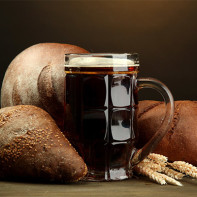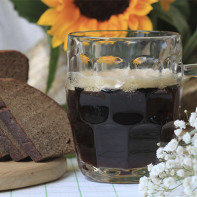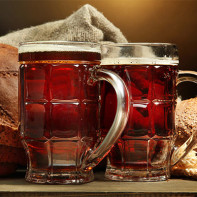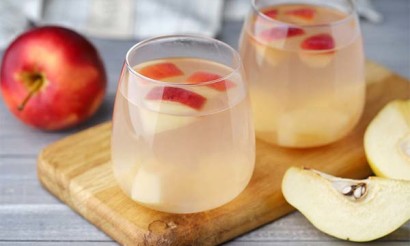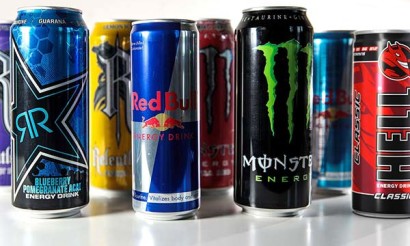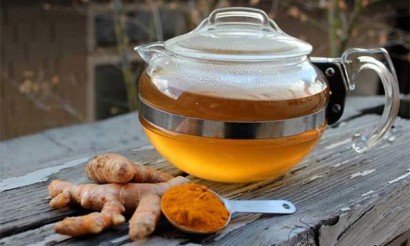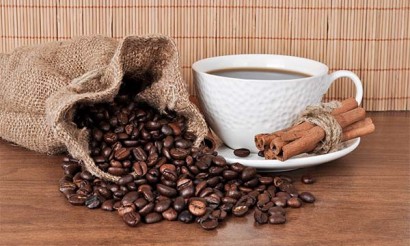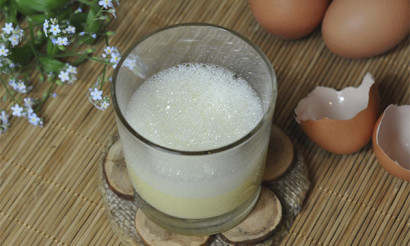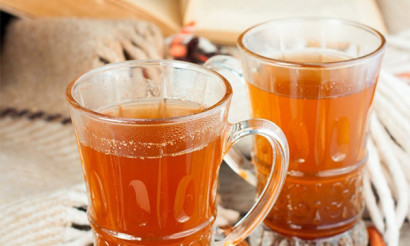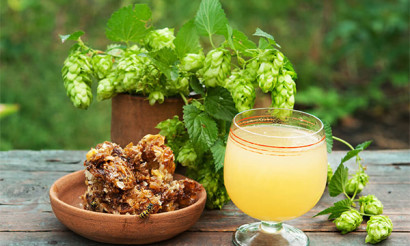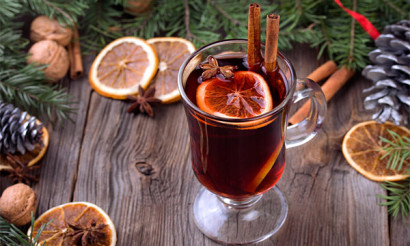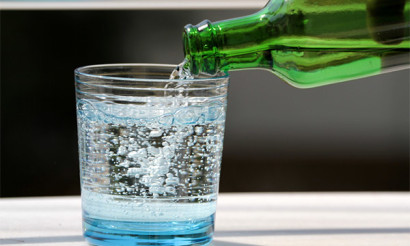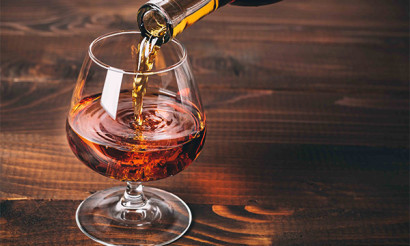Kvass: useful properties and contraindications
Kvass is a traditional drink of Slavic peoples. They quench their thirst with it and use it to prepare cold summer dishes. However, there is evidence that even 600 years BC such a drink was known to ancient Egyptians, who already then highly appreciated the tonic effect of kvass and its healing qualities for human health.
- What is kvass
- Types of
- Composition and caloric content
- What is useful for kvass
- General benefits
- For Women
- For Men
- While pregnant
- For breastfeeding
- For children
- When losing weight
- Useful properties of beet kvass
- The Benefits of Bread Kvass
- What is oat kvass useful
- Kvass in medicine
- For Diabetes
- For pancreatitis
- For Gastritis
- For the bowel
- For constipation
- For gout
- For the liver
- Cholecystitis
- Cosmetic use
- Hazards and Contraindications
- How to Choose and Store Kvass
- How to drink kvass correctly
- How much can I drink per day?
- Drinking at night and on an empty stomach
- Can I drink while driving?
- Can Kvass get you drunk?
- Can Muslims drink kvass?
- How to Make Homemade Kvass: Recipes
- From Bread
- From Beetroot
- From oats
- From rice
- From chicory
- From birch sap
- From cranberries.
- From apples.
- Can we give kvass to animals?
- Interesting facts about kvass
What is kvass
In its essence, kvass is a beverage with sour characteristics prepared from flour or rye bread and malt using a fermentation process. It refers to non-alcoholic beverage, although it contains a small part of alcohol - about 1.2%. They add honey, aromatic herbs, honeydew, and may use beets, fruits and berries as a base.
In Russia the first written evidence of the production of kvass dates back to the reign of Prince Vladimir, but before the XII century it was somewhat different from the modern drink. It was brewed thicker and with more alcohol than even today's beer. As time passed the hoppy variant began to be brewed and its low-alcohol counterpart became the fermented sour kvass that we know today.
The widespread distribution of kvass in our country and its exceptional popularity is also proved by folk epics and works of classical writers. It was loved and drunk willingly at all times of the year by people from all walks of life. It helped peasants to fight fatigue when working in the fields, craftsmen and workers in towns, quenched thirst in soldiers' barracks and hospitals, and was the guest of honor at feasts of high society and monastic refectories.
Types
One should not think that kvass is only a well known throughout our country as a dark brown drink made on the basis of rye bread. In fact there are many types, and each has its own unique and valuable properties. There are three categories of kvass - the well-known bread kvass, berry kvass and fruit kvass, which is made on the basis of the juice of well ripened fruit.
Today our national cuisine distinguishes traditional bread, apple, malt, sugar, milk, honey, fruit, berry, mint and beet kvass. In addition, daily kvass and okrosha kvass are separate.
Composition and calories
Lovers of diets and a healthy lifestyle look at kvass with apprehension, especially at the one that has in its name the unpopular word "bread". But it is by no means distinguished by its high caloric content: 100 ml of kvass contains only 27-30 kcal, which allows it to be classified as a diet drink.
Bread kvass gets all the minerals, proteins, vitamins, saccharides and polysaccharides that it inherited from the whole grains that were used for its production. It is extremely rich in essential amino acids: leucine, methionine, tryptophan, tirtosan, valine, phenylaolaline, lysine and threonine. The drink gets its dark color from the reaction products of proteins and amino acids. Kvass is rich in vitamins A, E, C, D, H and PP. It also contains phytic acid and carbonic acids. It also contains a whole chemical table of macronutrients: iron, copper, zinc, phosphorus, molybdenum, calcium, fluorine and cobalt.
What is kvass useful for
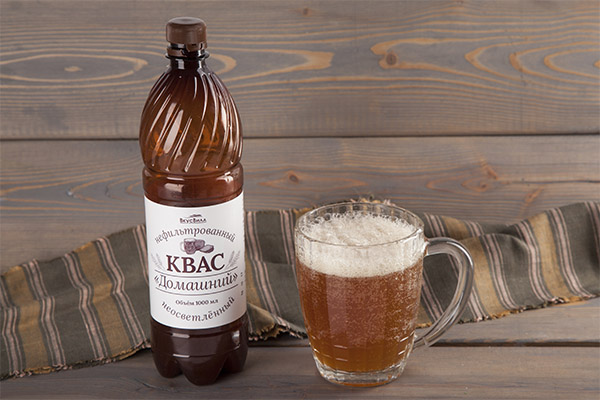
General benefits
Due to the unique composition of our favorite drink has an active and beneficial effect on human health. It helps the functioning of many body systems, to which we should refer first of all the digestive, as well as the urogenital, endocrine and other systems. Not only that, by consuming this or that kind of drink, we can direct its action to a specific area. The famous Russian scientist and encyclopedist Dmitry Mendeleev recommended drinking carrot kvass to remove cholesterol from the body, milk kvass to lower blood pressure and orange kvass to clean the blood vessels.
These magical properties are given to kvass by unicellular creatures hiding in it, known to us as yeast mushrooms. They penetrate the drink with the leaven, which is based on cereals or vegetables or fruits, or even from the surface of mint or blackcurrant leaves included in some recipes. Fungi are not only involved in the synthesis of vitamins, but are also involved in the fight against pathogenic bacteria. The enzymes produced by them help to break down the food eaten and help the body to assimilate the useful substances it contains. In fact, the effect of kvass on the body is quite comparable with the effect of consuming dairy products such as koumiss, kefir or yogurt.
For women
For women whose diet often includes kvass, it can become a real beauty elixir. Strong, thick shiny hair, healthy beautiful nails, young skin, which will be the envy of all friends - all this is impossible without organic acids, in abundance contained in the wonder drink. Moreover, phytohormones obtained with it help to overcome unpleasant feelings during menstruation or at the onset of menopause - a sudden change in pressure, "hot flashes", unexpected dizziness. With the help of vitamins and enzymes brought into the body, kvass helps the female body gently and naturally cleanse and rejuvenate.
For men
Kvass was not at the mercy of men either. They were all-powerful and tireless heroes of Russian epics. How did our national drink help them?
First of all, it contains large amounts of zinc, vitamins B and E, as well as amino acids - and it is these elements that stimulate the production of male sex hormones, without which there will be no heroic strength. It will also help men prevent prostate diseases, the appearance of adenoma and maintain potency for many years.
Kvas not only stimulates an increase in muscle mass, it helps to conserve energy during heavy physical work, increasing the overall stamina.
When pregnant
The magic wand of rejuvenation, vitamin E, which is rich in kvass, acts as a powerful antioxidant, supporting a woman's body during pregnancy. It helps it produce progesterone, an endogenous steroid that has a beneficial effect on human embryonic development.
The drink will supply the mother-to-be with the necessary ascorbic acid, which means that it will alleviate toxicosis, help prevent stretch marks and bruises.
Finally, B vitamins will make their valuable contribution to the full development of the baby. Phosphorus and calcium, without which a baby can't develop full-fledged bones, will also help this process. Kvas helps to normalize blood pressure and bowel function and eliminate the threat of constipation, which will make the waiting period even more joyful.
When breastfeeding
The same antioxidant, vitamin E, during breastfeeding has an increasing effect on lactation, and also increases the quality of breast milk and even improves its taste.
However, talking about the benefits of kvass for women during pregnancy and for breastfeeding mothers, it must be clarified that to the full extent all the positive effects of the drink can be guaranteed if it is live, prepared at home or by a well known producer. Otherwise, it will contain a lot of chemical additives - preservatives, colorants, flavor enhancers, etc.
For Kids
All the useful properties of kvass, known since ancient times, seem to suggest that all its qualities for adults would also be useful for children, but it should be taken into account that it contains a certain amount of alcohol. That is why doctors do not recommend giving the drink to children under the age of five or seven. In this case, as with any new product for the child, you should start with a small portion, up to a third of a glass at a time. Children over 7 years of age can consume one glass (200 ml).
A child whose diet includes kvass may get the full benefit of the lactic acid bacteria and yeast contained in it, which are favorable conditions for the development of metabolic processes, which is very important for a child's actively growing organism. Then come into play all the useful components of the drink, strengthening bone tissue and teeth enamel, normalizing the function of his intestines. They make up for possible vitamin deficiencies, delay the development of pathogenic microbes, enhance immunity, and make the metabolism stable.
When losing weight
People suffering from excess weight can benefit from the properties of kvass to promote the elimination of excess fluid, which helps to reduce overall weight. The drink strengthens collagen fibers, and the elasticity of the skin and thus the condition of the skin depend on them, which alleviates the problem of stretch marks. Finally, it leads to a slight increase in insulin in the blood and lowers sugar levels, which helps to create a feeling of satiety.
Useful properties of beet kvass
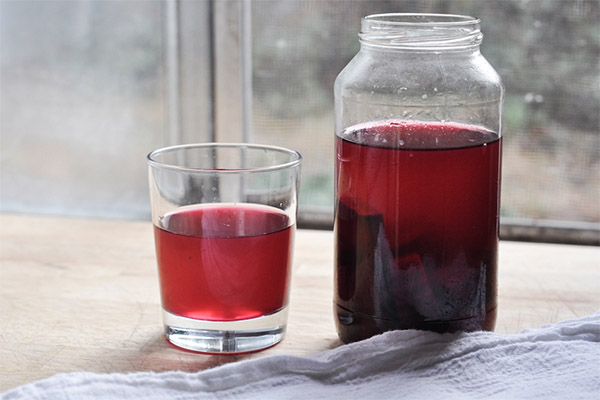
Beet kvass stands apart in the list of modern types of this drink. It has fully absorbed the healing qualities of its main ingredient - beet, which in ancient times was considered primarily a medicinal plant. Indeed, the results of years of research by scientists show that the use of beet kvass has the following beneficial effects on the organs and systems of the human body:
- prevention and treatment of constipation;
- The real reduction of cholesterol in the blood;
- relief from respiratory infections;
- Promotion of liver strengthening;
- assistance in the fight against atherosclerosis;
- pronounced anti-cancer effect;
- assistance in the fight against obesity;
- beneficial effect on kidney function;
- purification of the body from toxic substances;
- The relief of women during menstruation;
- Acceleration of metabolic processes;
- reducing the risk of dementia and Alzheimer's disease;
- strengthening the skin, connective tissue, bones and blood vessels;
- Acceleration of cell growth and regeneration of cell nuclei;
- favorable effect on the production of the necessary amount of gastric acid;
- reducing the risk of allergic reactions.
For the female body beet kvass is especially useful, because its high iron content helps to make up for the monthly blood loss. It also helps to a certain extent to relieve the negative effects of menopause, stimulating blood circulation and metabolism. But men should not forget that beet kvass successfully affects the hormonal background, contributes to the normal functioning of the genital system.
The Benefits of Bread Kvass
The exceptional usefulness of kvass in our country has been well known since ancient times. It not only gives vivacity and refreshment in hot weather, but also perfectly removes fatigue and helps to fight all kinds of diseases.
We should especially note the remarkable ability of kvass to normalize the intestinal function. Scientists discovered about 130 years ago that the acids in the drink, actively help to digest food of plant origin, rich in hard-to-digest fiber. The natural sour environment of kvass, which is created by double fermentation with lactic acid bacteria from leaven and special pure yeast, helps regulate the bacterial flora of the intestines, which has a beneficial effect on digestion. Thus, drinking kvass helps better assimilate the food you eat and affects healthy bowel emptying no worse than popular dairy products.
Kvass is a valuable source of vitamins. Especially important is that its yeast microorganisms contribute to the production of B vitamins, because our body is not able to create a reserve and is forced to extract them from the food that comes into it. Kvass gives us vitamin B1, which is necessary for cell development and maintaining the heart in a normal state, B2, which is responsible for the condition of the skin, hair and nails, B3, which can expand blood vessels and serves as a shield for our nervous system.
This drink also contains some vitamin C, which supports the immune system, and E, which slows down aging. It also contains very necessary trace elements such as calcium, phosphorus and magnesium. They ensure the construction of bones and muscle mass, streamline the work of the circulatory and nervous systems, provide energy for a wide range of biochemical and physiological processes of the body, ensure reliable operation of the heart.
Kvass is notable for its ability to quench hunger. In the old days this property was very helpful for the poor people who often did not have any other food. Hence the popular proverb: "Dish with meat, and no - so bread with kvass. On the other hand, as we have already seen, there are very few calories in this drink, so it can successfully be used as part of a dietary diet.
What is oat kvass good for?
The benefits of oat kvass in the people walk the legend. Indeed, it preserves the biologically active components and substances contained in oats. Folk healers and homeopaths actively use this drink to obtain positive effects for a number of diseases. It is indispensable for avitaminosis, gives positive results in the fight against diseases such as hypertension, diabetes, hepatitis C, tuberculosis, as well as excellent support strength in overwork, insomnia, exhaustion and neurasthenia.
The folic acid in oat kvass obtained with the drink by a woman during pregnancy will help to develop a healthy nervous system of the child. Also oat kvass has a slight diuretic and laxative effect.
Another important point is the favorable cosmetic effect of oatmeal drink, which adds lushness to the hair, supports skin turgor and strengthens the nails.
Finally, kvass helps to lose extra pounds without torturing yourself with exhausting diets, because its regular consumption accelerates the breakdown of fat in fat depots.
How to make it at home? You need to take about 400 grams of oats and rinse them thoroughly more than once. Pour the washed grains into a jar of 3 liters and fill it with sugar (5 tbsp.). All this pour 1 liter of boiled and cooled water. After what the neck of the jar to seal the gauze plug and put the jar in a warm place for three days, after which kvass can be drunk.
Kvass in medicine
Healing properties of the legendary drink have been known since ancient times. Today's medicine recognizes a number of its useful qualities, allowing to have a positive impact on the course of treatment of certain diseases. It uses the results of lactic and alcoholic fermentation of wort and the properties of the produced microorganisms.
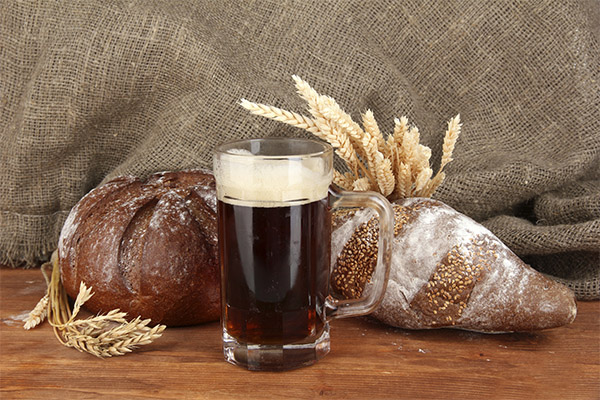
Medics use the ability of kvass to replenish vitamins and minerals in the body, strengthen the immune system, restore the digestive system, strengthen bone tissue and dental enamel, and have a beneficial effect on vision. The drink is able to help patients suffering from gastritis with reduced acidity, stress and neurosis, problems with the cardiovascular system, nasopharynx and bronchopulmonary system. Highly valued characteristics of the drink, allowing him to help reduce excess weight, purify the skin, combating purulent inflammation, have a detoxifying effect on the body.
For diabetes
It is possible and useful to consume kvass in type 2 diabetes. Immediately we should stipulate that this involves additional control, that is, you need to take into account the sugar of the drink in the total daily intake of carbohydrates. It is possible to replace kvass, which contains sugar as an ingredient, with a drink created on the basis of honey. For example, blueberry or beet types of drink have a direct effect on reducing blood glucose levels to normal levels.
Important: The glycemic index of kvass from 15 to 45 units.
In pancreatitis
In the presence of pancreatitis, the use of kvass is under great question. Yes, it is possible to drink it, but only in the stage of stable remission, in very limited quantities and with constant consultations with the attending physician. In other conditions doctors categorically forbid the use of this drink for a number of serious reasons. The organic acids contained in it, which are useful in other cases, lead to an increase in acidity, which ultimately in pancreatitis causes self-destruction of the pancreas. Another trouble is alcohol, which is contraindicated for patients with this disease even in microscopic doses. And also patients with this disease are contraindicated choleretic effect of the drink and harmful carbon dioxide, which causes them bloating of the stomach.
For gastritis
For people suffering from gastritis, drinking kvass requires extreme caution. If we are talking about gastritis with high acidity, from this drink, most likely, you will have to refuse, because it will increase the irritating effect of the aggressive environment, which is already present in the stomach.
With gastritis with reduced acidity, it is not necessary to exclude kvass from the diet. True, it is better to give preference to kvass on the basis of beet. Such a drink can be drunk twice a day, half a glass. It is not necessary to remind that it is necessary to monitor the reaction of the body to the received product and adjust the portion in case of a negative effect. Well, and in the period of exacerbation, of course, it is not necessary to use it.
For the intestines
Kvass has a beneficial effect on the intestines, in particular: increases the production of gastric juice and prevents gas formation, gets rid of heartburn and treats peptic ulcers, improves microflora and even removes some harmful bacteria from the body.
For constipation
According to numerous testimonies, kvass has the most favorable effect on the emptying of the bowels and can be used in this capacity for constipation. Of course, no one cancels the consultation with the attending physician.
With gout
With gout, the patient is forced to observe a special drinking regime to eliminate from the body an excessive amount of uric acid. In this case, it is necessary to drink 2-3 liters of fluid per day. In this case, kvass can be very useful because it strengthens the immune system and has an anti-inflammatory effect. Nevertheless, too much beverage can be harmful: sugar and fermentation products cause fluid retention, edema and aggravation of pain in the joints.
For the liver
The consumption of kvass has a positive effect on the condition and functioning of the liver, as it has the ability to strengthen the immune system, purify the cardiovascular system and replenish vitamins. Naturally, if we are talking about cirrhosis of the liver, there must be serious quantitative restrictions.
In cholecystitis.
With all the useful properties of kvass, it has the ability to stimulate the release of gastric juice, so in cholecystitis it is on the list of products restricted to consumption.
Cosmetic applications
We have already noted the beneficial effect that drinking kvass contains vitamins and minerals on the health of the skin, hair and nails. But the drink also has a separate role in cosmetology in its external application.
Freshly made beverage helps against freckles and age spots on the face, loose dermis and decreased elasticity of the skin, as well as in the presence of a large number of fine wrinkles. Kvass rubbed into the skin makes it healthy, fresh and velvety.
- A nourishing mask suitable for any type of skin: mix a ¼ cup of kvass with 1 tsp. honey and apple juice. Moisten gauze and put it on your face. Leave on face for 15 minutes and wash off with warm boiled water.
- Remedy to strengthen the nails and make them shiny: 1 tbsp. kvass and ½ tbsp. honey and lemon juice. Rub the mixture into the nails for 15 minutes. Continue every day for 2-4 weeks.
- Kvass is also quite effectively used to combat hair loss, dandruff and hair structure disorders (most often during coloring). By rubbing the drink into the scalp, you can strengthen hair follicles, relieve skin irritation and itching, remove dandruff.
- To prepare a mask for hair, you must mix 50 ml of kvass with 2 tablespoons of mayonnaise and add a few drops of lemon juice. Apply it to the face for 20 minutes, wrap warmly, then rinse with warm water.
Harm and contraindications
It is well known that there is no silver coin without a downside. So it is with kvass, with all the great benefits that the legendary drink brings us, we must be aware that there may be negative aspects in its consumption.
At the heart of the beverage production is a fermentation process, so it tends to sour. And in its sour form it can cause acute stomach upset or even cause poisoning. Also the alcohol it contains, depending on the individual characteristics of the individual consumer, can cause a state of weak intoxication, dangerous to drive.
Kvass is also not useful for certain illnesses. For example, its use is limited for patients with gastritis, high stomach acidity, high uric acid, diabetes, cirrhosis of the liver, urolithiasis and low blood pressure.
How to choose and store kvass
When buying kvass in the store it is advisable to follow the following rules.
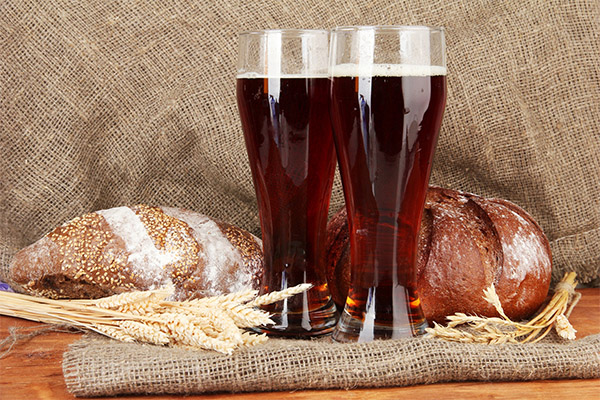
- It should give foam, which indicates the correct content of carbon dioxide.
- The presence of sediment signals a violation of technological rules of production.
- As with other foodstuffs you buy, you must check the expiration date and the composition, which may only contain water, rye flour, malt, sugar and yeast.
- It is better to give preference to a dark container, which protects the drink from the damaging effects of sunlight.
The general rules for storing the drink are as follows: in a tightly closed container in a dark and cool place (plus 2 to plus 12 degrees). If we are talking about bottled kvass, under the same conditions it may be stored from 3 to 5 days. Once the bottle is opened it can only be kept in the fridge and for no longer than 3 days.
How to drink kvass correctly
How to enjoy this national drink, everyone chooses independently and to their own taste, but there are a few rules that it would be nice to know.
How much you can drink per day
Doctors do not put any strict limits on the daily norm of kvass, but still urge to be guided by common sense and not drink more than 800 ml at a time. Given all of its properties, 1-2 glasses a day may be recommended. The most universal recipe in this case is to listen to your body, and it will tell you when it is time to stop.
Can I drink at night and on an empty stomach?
With all the useful qualities of kvass to drink it at night will not be the best idea, because it can cause fermentation in the gastrointestinal tract, fraught with unpleasant consequences in the form of flatulence. Moreover, it is likely to increase the level of acid in the stomach, which is very undesirable, especially when the body is in a horizontal position, as it is fraught with the occurrence of heartburn.
The same reasoning applies entirely to drinking kvass on an empty stomach. However, if it happens at the beginning of the day, the pluses from its consumption are still more, taking into account its tonic qualities.
Can I drink while driving?
The official norms of alcohol at the driver are 0,16 ppm in the exhaled air and 0,35 ppm during the blood test. Considering that kvass is allowed up to 1.2% alcohol content, it would seem almost impossible to drink it in an amount that would exceed the permissible limits. Nevertheless, according to experts, even this content of alcohol in the drink makes it impossible for a person who sits behind the wheel of a vehicle to drink it. In addition, no one can guarantee how your body will react to such an amount of alcohol.
Is it possible to get drunk from kvass
This question immediately provokes a negative answer. For the drink contains a negligible amount of alcohol: according to State Standard no more than 1.2% of ethyl alcohol. Taking into consideration the speed of natural excretion of alcohol from the organism to get at least a light intoxication (the level of 0,4 ppm) one should drink from 3,5 to 5 liters of kvass within an hour, which is hardly feasible. Nevertheless the individual characteristics of a particular person's body can lead to unexpected results.
Can Muslims drink kvass
According to the evidence of the Islamic Information Portal, kvass belongs to the permissible drinks for Muslims, because it contains the percentage of alcohol, which can not cause intoxication. Nevertheless, one should be careful because kvass, if kept for a long time, can begin to ferment and, consequently, become intoxicating. In this case, its use will fall under the ban. Plus, we should not forget that we are all different, and everyone's reaction to the alcohol content of kvass is impossible to predict.
Recipes for making homemade kvass
From bread
The recipe for making bread kvass has not changed much over the past few hundred years. The effort spent on making the drink at home will be more than repaid by its useful properties that cannot always be obtained from industrially produced kvass.
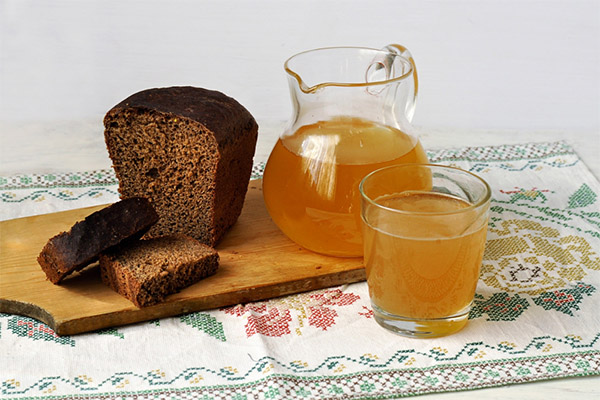
Rye bread kvass (yeast version)
Ingredients:
- Rye bread - 500 g.
- Drinking water - 5 l.
- Sugar - 250 gr.
- Dry yeast - 5 gr.
- Cut the black bread into small cubes. Heat the oven to 180 degrees and put in it sliced bread on a tray. Dry the bread until it forms a thin ruddy crust. It is important not to over-dry the bread until it turns black.
- Boil the prepared water and cool it. Pour into a large glass jar. Pour the breadcrumbs in the water. We seal the jar with a gauze plug and put it in a dark place for about one day.
- Now filter the mash obtained. First we squeeze the breadcrumbs, then filter the liquid through gauze in several layers into a new clean jar.
- To start the fermentation process, pour 200 grams of sugar into the jar and pour the diluted yeast.
- Close the jar with a lid so that there is a gap where carbon dioxide from the fermentation process can escape. Again we put a jar in a dark room at room temperature for 15-16 hours.
- The finished drink strain for the last time and add the remaining 50 grams of sugar. Stir thoroughly. Pour kvass in bottles, tightly closed and put in the refrigerator.
From beets.
Ingredients:
- Medium beets - 4 pcs.
- Small carrots - 2 pcs.
- Drinking water - 3 liters.
- Beets are washed, peeled, cut into small pieces (1x1 cm), put in a 3 liter jar.
- Cut carrots into julienne strips and add them to the beets.
- Fill the jar with cold drinking water, seal it with a gauze plug and leave in a dark place for a few days. When the fermentation passes, gas bubbles will rise from the bottom of the jar to the top and the drink will take on a rich burgundy color. This means that the kvass is ready for drinking.
- Juices of currants, cranberries, rowanberries, or sea buckthorn can be added in various proportions to the ready kvass. It is permitted to add a small amount of kefir, chopped herbs, spices to taste - this will positively affect the taste of kvass and strengthen its useful properties.
With oats
This old Slavic type of kvass served as a reliable source of vitamins and essential minerals all year round, especially during the fasts, and even replaced some medicines.
Ingredients:
- Oats - 200 g.
- Drinking water - 800 ml.
- granulated sugar - 30 g.
- Rinse the oats thoroughly with cold water several times. We sort and exclude spoiled grains. Transfer to a 3 liter glass jar.
- Pour sugar in a jar, pour cold water, cover with gauze and put in a warm room with access to sunlight for 4 days. The first batch is ready. This process can be repeated by pouring new water and a new portion of sugar up to 10 times.
From Rice
This kvass came to us from China. It's especially good if you need to stabilize your stomach. Plus, the drink helps fight spine and joint problems.
Ingredients:
- White rice - 120 g.
- Drinking water - 2 liters.
- Raisins - 50 gr.
- Sugar cane - ½ cup.
- Dry yeast - 8 gr.
- Boil the water and cool it to 25 degrees. Dissolve sugar in it and pour into a glass jar.
- Pour the rice without rinsing it into a jar with water, add the raisins.
- Pour dry yeast on the surface of the water in the jar, do not stir, tie it with gauze and put it in a warm room for a day.
- Ready kvass strain, pour into bottles and store in the refrigerator.
From chicory
This type of kvass is very suitable for busy city dwellers, as it does not require much labor and is prepared in record time.
Ingredients:
- Chicory powder - 80 g.
- Drinking water - 5 liters.
- Sugar - 300 gr.
- Citric acid - 20 gr.
- Dry yeast - 4 gr.
- At the beginning of cooking a little warm a glass of water, so that it is a little warmer than room temperature, and dilute the yeast.
- Dilute the chicory, granulated sugar and citric acid in a saucepan, add the diluted yeast and stir thoroughly.
- Cover the pot with a gauze plug and let it stand for 4-5 hours at a temperature of 21-25 degrees.
Rye bread kvass with chicory
Ingredients:
- Chicory powder - 20 grams.
- Drinking water - 7 ml.
- Dry sourdough - 200 gr.
- Sugar - 275 gr.
- Raisins - 40 gr.
- Rye bread crumbs - a handful.
- Make sourdough. Pour into a three-liter jar 100 g of dry sourdough, 120 g of sugar, dry yeast and raisins. Pour in 2 liters of warm water and stir well. Cover the jar with a gauze plug and place it in a warm room for 2 days. Drain the liquid from the sediment in the jar - you get the starter.
- Mix it with 2 tablespoons of dry kvass, 2 tablespoons of sugar and pour 2 liters of water. Leave for another 2 days.
- We throw away the liquid from the sediment, we get ready starter, which we mix in a 3-liter jar with 5 tbsp. sugar, 2 tbsp. dry kvass, ½ tsp. yeast and chicory.
- Fill the jar to the top with warm water and put in a warm place for 3 days. The resulting kvass strain into bottles and store in the refrigerator.
From birch sap
This type of kvass usually does not cause any particular difficulties in production. The main requirement is that the birch sap is collected in time and competently. So that very little effort will be rewarded with an excellent taste of a wonderful refreshing drink.

Ingredients:
- Freshly picked birch juice - 3 liters.
- Rye bread - 300 gr.
- Sugar - 100 gr.
- Black currant leaves - 10 pcs.
- Raisins - 30 g.
- Rye bread is cut into small cubes and dried in the oven.
- Filter the birch juice through gauze into a saucepan and heat on the stove, do not let it boil.
- Mix the juice with the obtained rye breadcrumbs and sugar. Add washed currant leaves and raisins.
- Tie the jar with gauze and put it in a warm place for up to 5 days. Ready kvass pour into bottles and store in a dark cool place.
Birch kvass with orange
Ingredients:
- Birch juice - 2,5 liters.
- Orange - 1 pc.
- Sugar - 100 gr.
- Fresh yeast - 5 gr.
- Mint leaves - 10 pcs.
- Raisins - 20 gr.
- Filter the birch juice (freshly harvested is better) into a large container.
- Orange slice into thin slices and put it in the juice. Pour some juice into a mug, dilute yeast and sugar in it, add it back to the juice.
- Pour the mint into the container, cover with gauze and put in the heat for 2 days.
- Then strain, pour into bottles, add a few raisins to each bottle, seal and store in the refrigerator.
From cowberries
Lingonberries are extremely appreciated by experts not only for their taste, but also for their healing features. Kvass from this berry is not known to all home craftsmen. Those who master the technology of cooking this drink, however, it will give its remarkable taste and refreshing properties.
Ingredients:
- Drinking water (cold) - 4 liters.
- Lingonberry - 5 cups.
- Yeast - 8 g.
- Sugar - 400 gr.
- Raisins - 20 gr.
- Lingonberries are picked, washed and crushed a little, so that it starts to secrete juice. Place in a large saucepan, pour cold water and boil after boiling for 15 minutes over low heat.
- Cool the broth, filter the berries and combine with the yeast and sugar, and then leave for about 6 hours.
- Then pour the kvass into bottles, preliminarily throwing in each a little raisins, and put in a cool room for 2 days. The drink is ready to drink.
With apples
For apple kvass fit fully matured apples of juicy varieties. It does not require any special expenses, time or skills of a cook. It is only necessary to exact the time required for its fermentation and ripening, and you can get a delicious carbonated refreshing drink.
Ingredients:
- Apples - 0.7 kg.
- Drinking water - 2 liters.
- Sugar - 80 g.
- Dry yeast - ½ tsp.
- Pour water into a large saucepan, preferably enameled, and bring to a boil.
- Rinse the apples and cut into eight pieces. We discard the spoiled parts of the fruit, cutting them off and throwing them away. Remove the seed pods and stalks from the sliced slices.
- Put the apples into a saucepan, bring to the boil again and keep on medium heat for another 7 minutes. Taste the resulting compote for sugar, if the taste is sour, add sweetness.
- Cool the pot to room temperature and strain to remove all the pieces of apples. In a small volume of the resulting drink dilute the yeast and pour into the pan. After stirring all the ingredients well, cover the pot with gauze and place it in a warm place for 12 hours to ferment.
- Pour the drink into bottles or other hermetically sealed containers and place them in the refrigerator for up to 5 days to mature. Ready kvass can be kept in the refrigerator for up to 2 weeks.
Can we give kvass to animals?
Usually veterinarians do not recommend giving animals anything exotic or not part of their normal diet. After all, there is always the danger of an allergic reaction to any ingredient in the food or drink. For example, a percentage of alcohol that is unnoticeable to humans may be toxic to the pet. In particular, dog breeders are of the opinion that if a pet asks for kvass, it lacks some vitamin in its body, which it can get from the drink. Most often it is group B. In this case, it will be better to buy the dog a special supplement with these vitamins or to make a diet so that with the help of products to eliminate this deficiency.
Interesting facts about kvass
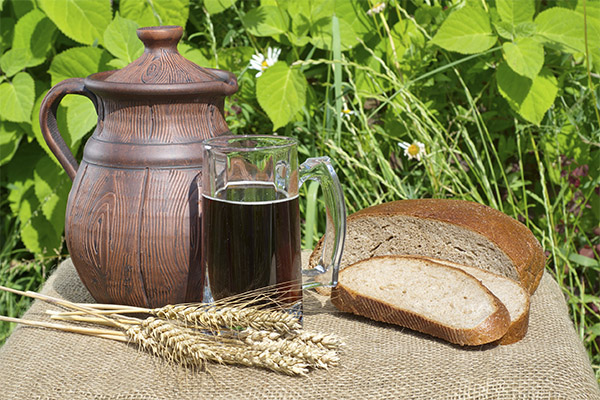
- According to Russian chronicles from 996, Prince Vladimir during the conversion of Russia to Christianity ordered to treat the newly converted with kvass along with food and honey. This is the first written evidence of how kvass became widespread and popular in Russia.
- From time immemorial kvass was not only popular among the people, but also favoured by royalty, particularly by the Romanov dynasty. For example, Alexey Mikhailovich, who reigned in the middle of the 17th century, ordered to put kvass on the tables during his wedding feast. And later Peter the Great held this drink in great esteem - for him kvass was made according to a special recipe of the tsar, with the addition of horseradish. Prince Grigory Potemkin also favored the traditional drink: he personally supervised the preparation of kvass for his table and invariably included kvass soup in the menu for his travels and military campaigns.
- In the olden days the masters engaged in the production of kvass were called "kvassnik". As a rule, they sold their products in special places called "kvass rows" or "kvass yards". In particular, such rows, built in Kostroma in the very beginning of the XIX century, have been preserved up to now very well, decorating the city with their exquisite and smart architecture, being one of the tourist attractions. Kvasnikov could be seen from afar by their professional headdresses resembling a wide cylinder, and large glass vessels in which they distributed their products. Each had its own narrow specialization, so there were "apple" or "strawberry" kvassniks and so on. They held priority in the sale of refreshing drinks until the nineteenth century, when they gradually began to be overtaken by the growing popularity of the tea trade.
- Among the professionals involved in the beverage production, it is well known that at an international contest of 1975, held in Yugoslavia, a beverage brought from the USSR under the brand "Moscow Kvas" was very highly appreciated by the jury for its taste qualities: it was awarded 18 points. At the same time the kvass left far behind the famous Coca-Cola, which received only 9.8 points.
«Important: All information on this site is provided for informational purposes only. purposes only. Please consult with a health care professional before using any of our recommendations. specialist before applying any of the recommendations. Neither the editors nor the authors are liable for any possible harm caused by materials."


